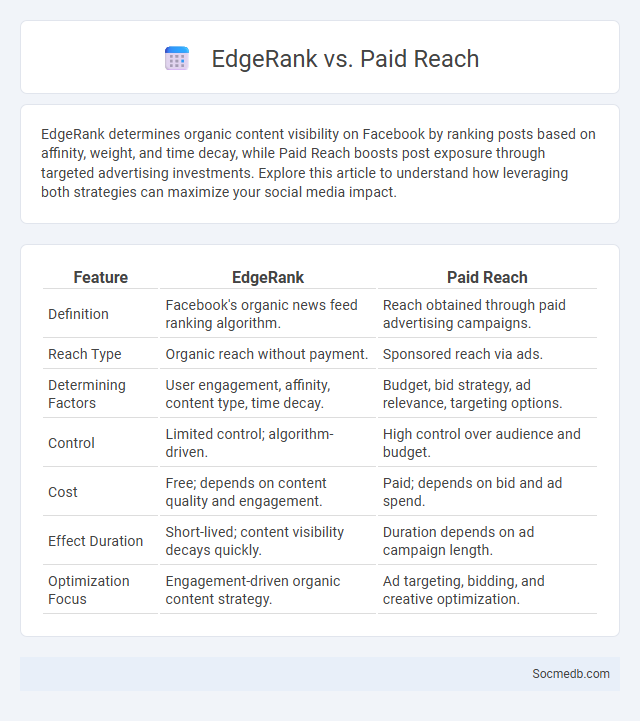
Photo illustration: EdgeRank vs Paid Reach
EdgeRank determines organic content visibility on Facebook by ranking posts based on affinity, weight, and time decay, while Paid Reach boosts post exposure through targeted advertising investments. Explore this article to understand how leveraging both strategies can maximize your social media impact.
Table of Comparison
| Feature | EdgeRank | Paid Reach |
|---|---|---|
| Definition | Facebook's organic news feed ranking algorithm. | Reach obtained through paid advertising campaigns. |
| Reach Type | Organic reach without payment. | Sponsored reach via ads. |
| Determining Factors | User engagement, affinity, content type, time decay. | Budget, bid strategy, ad relevance, targeting options. |
| Control | Limited control; algorithm-driven. | High control over audience and budget. |
| Cost | Free; depends on content quality and engagement. | Paid; depends on bid and ad spend. |
| Effect Duration | Short-lived; content visibility decays quickly. | Duration depends on ad campaign length. |
| Optimization Focus | Engagement-driven organic content strategy. | Ad targeting, bidding, and creative optimization. |
Understanding EdgeRank: The Basics
EdgeRank is Facebook's algorithm that determines which posts appear in Your News Feed based on affinity, weight, and time decay. Affinity measures Your relationship with the content creator, weight evaluates the type of interaction (likes, comments, shares), and time decay prioritizes newer content. Understanding these factors helps optimize social media strategies for higher visibility and engagement.
What is Paid Reach on Facebook?
Paid Reach on Facebook refers to the number of unique users who see your content as a result of paid advertisements or boosted posts. This metric is crucial for measuring the effectiveness of your ad spend and targeting strategies, helping you understand how far your promotional content extends beyond organic reach. Optimizing Paid Reach allows you to increase visibility among specific audiences, enhancing engagement and potential conversions.
EdgeRank vs Paid Reach: Key Differences
EdgeRank determines the organic visibility of your social media posts by evaluating factors like affinity, weight, and time decay, shaping how content appears in users' news feeds. Paid Reach, on the other hand, guarantees exposure by targeting specific audiences through sponsored advertisements, bypassing algorithmic limitations. Understanding the balance between EdgeRank's influence on organic engagement and Paid Reach's precise audience targeting can optimize your overall social media strategy.
How EdgeRank Influences Organic Content
EdgeRank algorithm determines the visibility of organic content on social media platforms by prioritizing posts based on affinity, weight, and time decay factors. High engagement rates, including likes, comments, and shares, significantly boost a post's EdgeRank score, increasing its reach within users' newsfeeds. Timely content combined with strong user interaction enhances organic visibility, driving more authentic audience engagement without paid promotion.
The Role of Paid Reach in Boosting Visibility
Paid reach on social media platforms significantly enhances your content's visibility by targeting specific audiences based on demographics, interests, and behaviors. Utilizing paid advertisements increases the likelihood of engagement from potential followers who may not encounter your organic posts, thus expanding your brand presence. Strategic investment in paid reach allows you to amplify campaign effectiveness, drive higher traffic, and generate measurable ROI through precise analytics.
EdgeRank: Factors That Matter Most
EdgeRank, Facebook's algorithm, prioritizes content based on three key factors: Affinity, Weight, and Time Decay. Affinity measures the relationship between you and content creators, while Weight evaluates the type of engagement such as likes, comments, and shares, with comments carrying higher importance. Time Decay ensures that newer posts appear more prominently in your feed, making timely and interactive content essential for maximizing visibility.
Paid Reach Strategies: Making Your Budget Count
To maximize Paid Reach Strategies on social media, targeting specific demographics, interests, and behaviors ensures your budget delivers optimal engagement and conversions. Utilizing A/B testing and real-time analytics allows you to refine ad placements and content, stretching every dollar for better ROI. Your campaign's success hinges on precise audience segmentation and continuous performance monitoring to make informed budget decisions.
Measuring Results: EdgeRank and Paid Reach Metrics
EdgeRank, Facebook's algorithm, determines the visibility of posts in user feeds by evaluating affinity, weight, and time decay, directly impacting organic reach metrics. Paid reach metrics measure the number of unique users who see a sponsored post, offering precise insights into campaign effectiveness and return on ad spend (ROAS). Combining EdgeRank analysis with paid reach data enables marketers to optimize content strategy, improve audience targeting, and enhance overall social media performance.
Combining EdgeRank and Paid Reach for Maximum Impact
Combining Facebook's EdgeRank algorithm with paid reach strategies amplifies content visibility by optimizing organic engagement while strategically targeting ads to relevant audiences. Leveraging EdgeRank factors such as affinity, weight, and time decay enhances natural post distribution, whereas allocating budget to paid reach ensures consistent exposure beyond organic limits. This integrated approach maximizes social media impact by driving higher engagement rates, improved brand awareness, and increased conversion potential.
Future Trends: The Evolving Facebook Algorithm
The evolving Facebook algorithm increasingly prioritizes meaningful interactions and personalized content, leveraging advanced AI and machine learning to enhance user engagement. As your organic reach adjusts, businesses must adapt by creating authentic, community-focused posts while integrating video and live-stream features to stay relevant. Data-driven insights and real-time analytics will play a crucial role in optimizing content strategies for future social media success.
 socmedb.com
socmedb.com